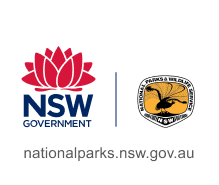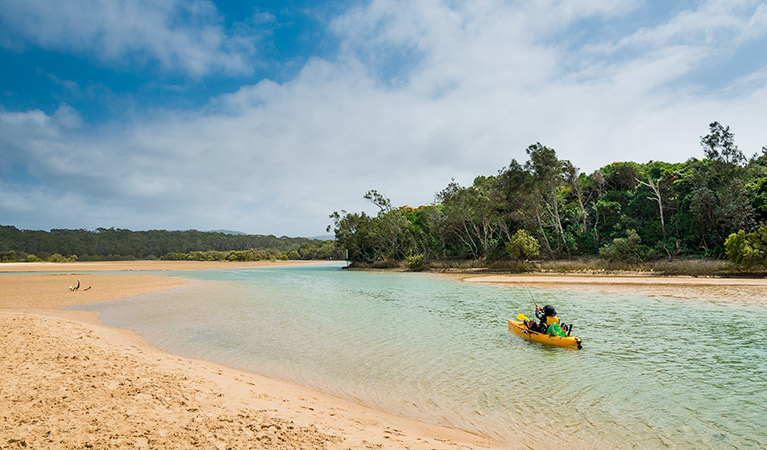Overview
For those into kayaking, canoeing or fishing, Moonee Creek canoe route is the ideal alternative way to enjoy the reserve. This pristine estuary is at the southern end of Moonee Beach.
- Where
- Moonee Beach Nature Reserve in North Coast
- Accessibility
- Hard
- Distance
- 3km one-way
- Time suggested
- 3hrs
- Grade
- Easy
- What to
bring - Drinking water
- Please note
- Please be aware that Moonee Creek is tidal and the direction of the tide will effect your travel time and difficulty level
- Eastern grey kangaroos inhabit the reserve. They are powerful wild animals capable of causing serious injury if threatened, so please appreciate them from a distance.
- Remember to take binoculars in you want to bird watch or whale watch
What could be more relaxing than a day paddling, kayaking or canoeing in Moonee Creek? This estuary is part of Solitary Islands Marine Park which was the first marine park to be created in New South Wales. Tranquil and tree-lined, the creek offers a way to explore the southern section of the park.
You can easily spend the whole day enjoying this beautiful estuary. Pack a picnic lunch and fishing rods for catching bream and flathead. Bring along your binoculars for birdwatching – the wildlife is plentiful. The kids can swim, lilo, or wade through the shallows, and, if you check the tides, it can be a very easy trip on the gentle current.
Different forest types can be found in Moonee Beach Nature Reserve, such as littoral rainforest, coastal she-oak and banksia woodland. Try and pick out which is which while passing on your canoe, and keep a waterproof camera handy for that sought-after photograph of a sleeping koala.
Map
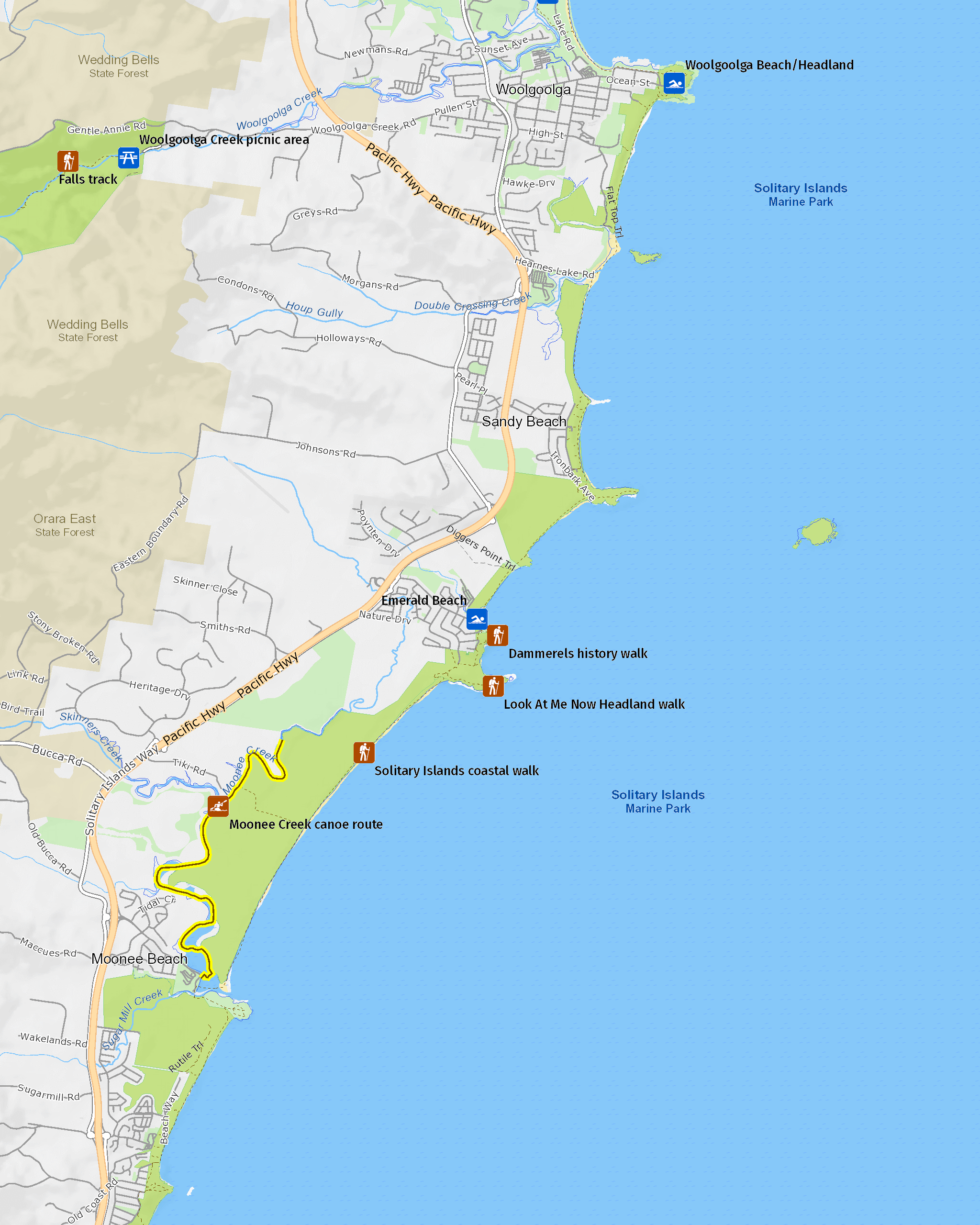
Map legend
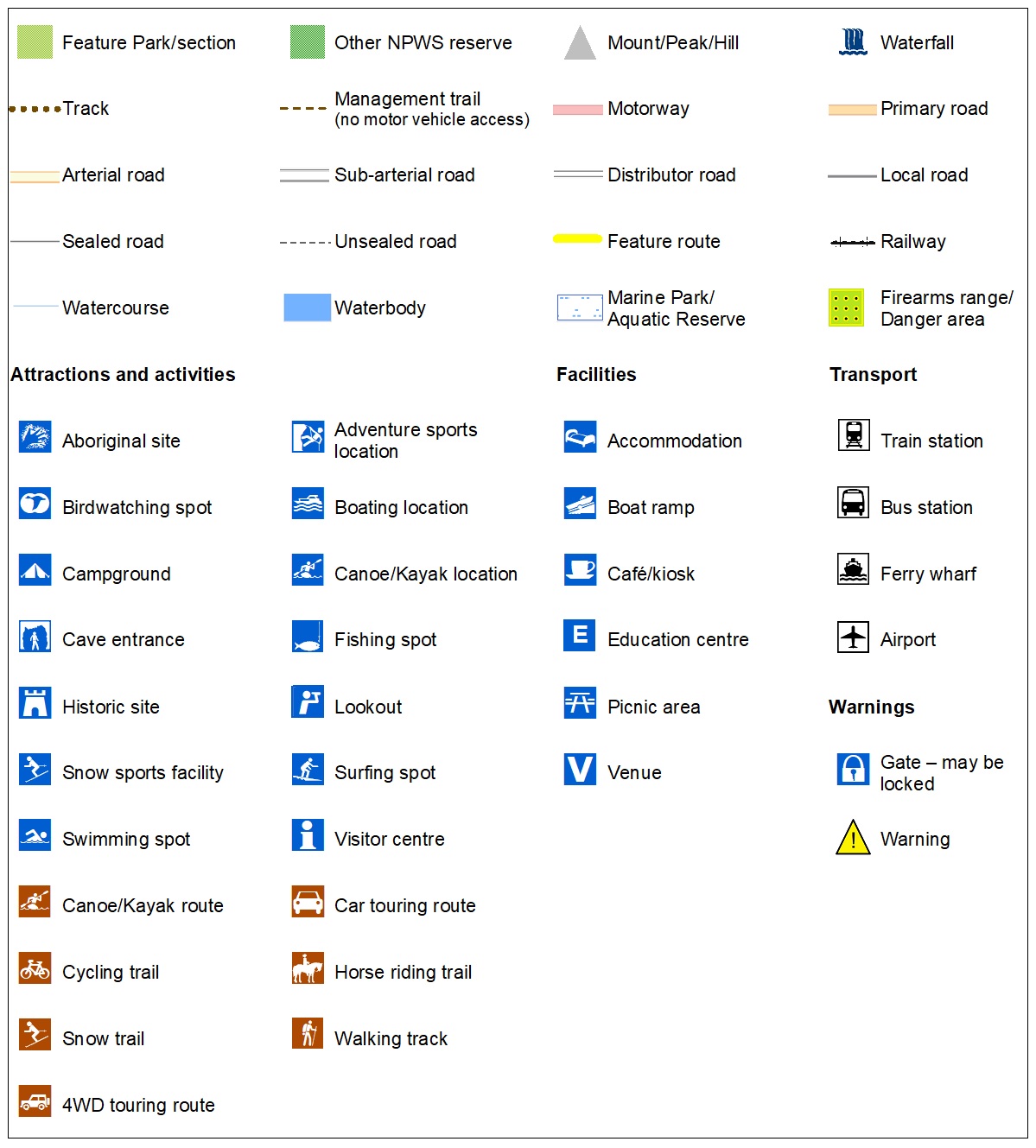
Map
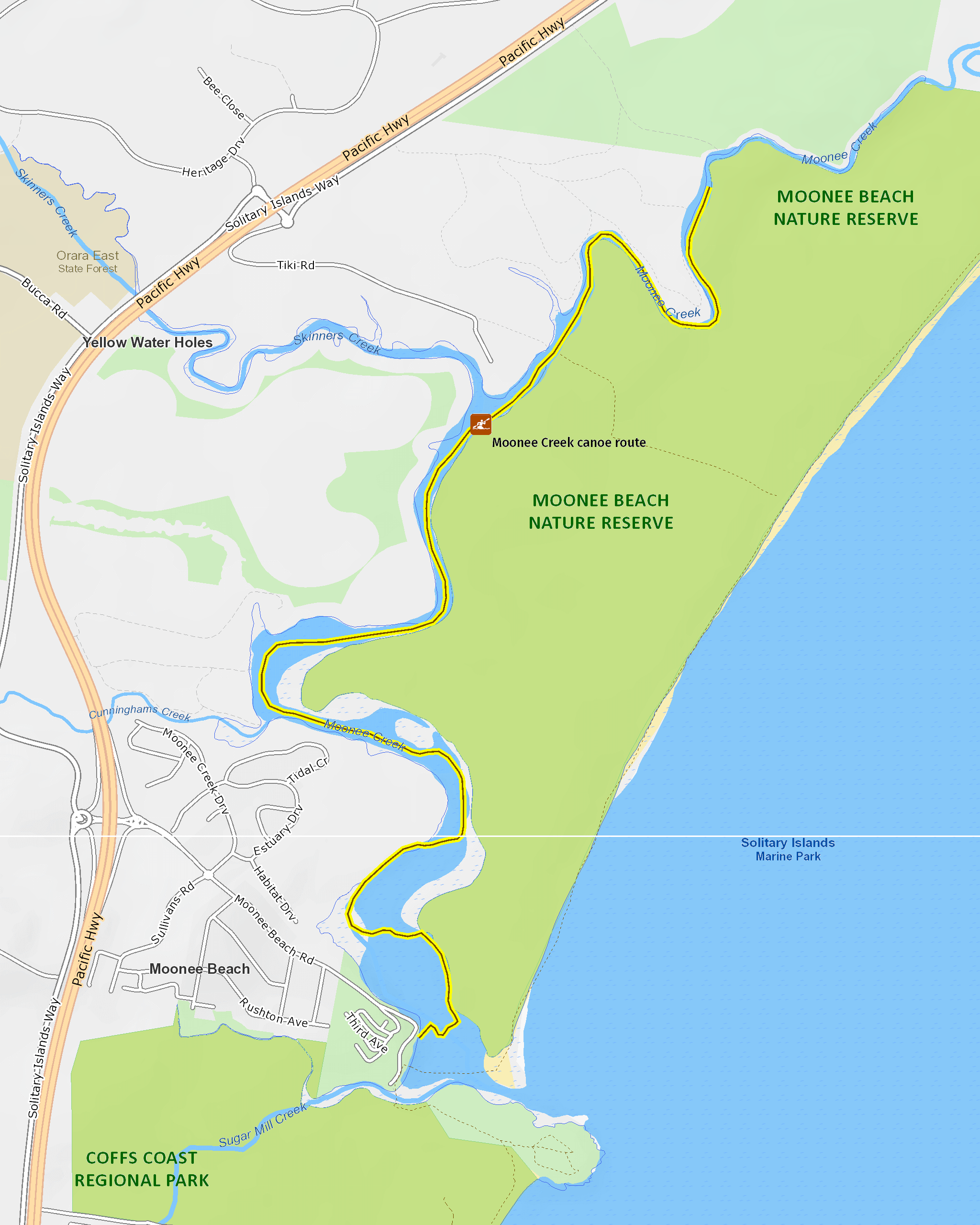
Local alerts
For the latest updates on fires, closures and other alerts in this area, see https://www.nationalparks.nsw.gov.au/things-to-do/canoeing-paddling-experiences/moonee-creek-canoe-route/local-alerts
Park info
- in Moonee Beach Nature Reserve in the North Coast region
Moonee Beach Nature Reserve is always open but may have to close at times due to poor weather or fire danger.
Visitor info
All the practical information you need to know about Moonee Creek canoe route.
Getting there and parking
Get driving directions
Moonee Creek is in the southern precinct of Moonee Beach Nature Reserve. To get there:
- Take Moonee Beach exit from Pacific Highway
- Continue on Moonee Beach Road to the council reserve carpark at the end of the road
- Launch your vessel from the boat ramp or other creek access point
Parking
Parking is available at Moonee Creek canoe route, including several designated disabled spots. It can be a busy place on the weekend, so parking might be limited.
Best times to visit
There are lots of great things waiting for you in Moonee Beach Nature Reserve. Here are some of the highlights.
Spring
This is the tail end of whale watching season, but the beginning of the best time for birdwatching and wildflower displays.
Summer
Enjoy a dip in the ocean or a splash around in the estuary when the weather's at its hottest.
Winter
Whale migration begins in this season, and you'll find uninterrupted views of the ocean from beaches, headlands and walking tracks.
Weather, temperature and rainfall
Summer temperature
Average
18°C and 26°C
Highest recorded
43.3°C
Winter temperature
Average
7°C and 19°C
Lowest recorded
-3.2°C
Rainfall
Wettest month
March
Driest month
September
The area’s highest recorded rainfall in one day
781.9mm
Facilities
There is limited water available in this park, so it’s a good idea to bring your own.
Maps and downloads
Accessibility
Disability access level - hard
Wheelchairs can access this area with some difficulty.
Permitted
Fishing
A current NSW recreational fishing licence is required when fishing in all waters.
Prohibited
Pets
Pets and domestic animals (other than certified assistance animals) are not permitted. Find out which regional parks allow dog walking and see the pets in parks policy for more information.
Smoking
NSW national parks are no smoking areas.
Learn more
Moonee Creek canoe route is in Moonee Beach Nature Reserve. Here are just some of the reasons why this park is special:
Rare and threatened

Little bent-winged bats roost in nursery caves on the headlands of Moonee Beach Nature Reserve. Producing only one offspring each year and being particularly vulnerable to disturbance by humans, they are, unsurprisingly, an endangered species. Eastern grey kangaroos are found throughout the reserve and swamp wallabies frequent the coastal rainforests and heathlands. 80 bird species are known, including 10 endangered species, such as sooty and pied oyster-catchers and black-necked storks. Five threatened plant species survive in the salt spray and shallow soil on the surface of the headlands. To the untrained eye these plant communities, hidden within the grass, don't look like much. But to a botanist they are EEC (ecologically endangered communities) and their plight probably keeps some of them awake at night.
- Look At Me Now Headland walk It’s an easy hike along Look At Me Now Headland walk, with scenic views all the way and a lookout over Moonee Beach. This is a great place for whale watching in winter and birdwatching in spring.
- Moonee Creek canoe route For those into kayaking, canoeing or fishing, Moonee Creek canoe route is the ideal alternative way to enjoy the reserve. This pristine estuary is at the southern end of Moonee Beach.
Settling in

The 1880s were a big decade for newcomers to the area and the history is fascinating. From 1884, South Solitary Island signal station was operated by the Dammerel family. Only a couple of years into what would become a 40-year job, there was a collision at sea between Keilawarra and Helen Nicoll. Lone fossicker Frederick Fiddaman spent much of the 1880s searching for gold, and evidence of his toils can still be seen at Diggers Point. A century later, locals protested long and hard, successfully preventing the area becoming a site for sewage ocean outfall. Only in 1995 were Look At Me Now Headland, Diggers Point and Bare Bluff added to the reserve.
- Dammerels history walk Dammerels history walk is a short, easy stroll taking in historic sites, scenic views and the pioneering heritage of South Solitary Island. Whale watching and birdwatching is recommended.
This powerful place

Look At Me Now Headland is significant to local Gumbaynggirr people as an important mythological site and a powerful place within their homeland. Evidence of everyday lives of Aboriginal heritage and its people remains in the form of middens, campsites, ceremonial sites and areas where stone axes were ground. The name Moonee comes from 'Munim-Munim', which is the Gumbaynggirr name for the area. It means 'rocky', reflecting the original importance of this place for axe-making.
- Look At Me Now Headland walk It’s an easy hike along Look At Me Now Headland walk, with scenic views all the way and a lookout over Moonee Beach. This is a great place for whale watching in winter and birdwatching in spring.
Plants and animals protected in this park
Animals
-

Australian pelican (Pelecanus conspicillatus)
The curious pelican is Australia’s largest flying bird and has the longest bill of any bird in the world. These Australian birds are found throughout Australian waterways and the pelican uses its throat pouch to trawl for fish. Pelicans breed all year round, congregating in large colonies on secluded beaches and islands.
